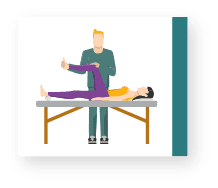You and your doctor may decide there are some things you can do now to see if you can manage your pain without surgery.
Treatment
without
surgery
What can I do now?

Lifestyle changes
Weight loss and exercise may help.1 Talk with your doctor about the types of exercises that may strengthen your leg muscles and help reduce pain. For people with mild or moderate osteoarthritis of the knee, certain exercises, like walking, may help improve how their knee feels and help them postpone surgery.1

Physical therapy
Physical therapists can help lessen your pain by teaching better posture or “form” for your day-to-day activities, like getting in and out of a chair. Physical therapists can also teach you how to use assistive tools like a cane or walker so you can be more active with less stress on your knees. Your physical therapist may also recommend walking and strengthening exercises depending on your anatomy, joint functioning, and disease progression.

Medication
Your doctor may recommend over-the-counter or prescription anti-inflammatory medicines to take the edge off the swelling and pain in your knee joint. Non-steroidal anti-inflammatory drugs (NSAIDs), like ibuprofen, and steroid medications, like corticosteroid injections, may be helpful.2 Use of these medications must be monitored by your doctor.
Talk with your doctor about the non-surgical approaches to decreasing your knee pain. If these approaches don’t lessen your pain, you’ve still got options.
References:
- Avoiding hip or knee surgery: Harvard Health Letter. Harvard Health Publishing, Harvard Medical School, June 2013. www.health.harvard.edu/pain/avoiding-knee-or-hip-surgery.
- Cortisone shots. Mayo Clinic, Mayo Foundation for Medical Education and Research. www.mayoclinic.org/tests-procedures/cortisone-shots/about/pac-20384794. Accessed 16 Apr. 2018.